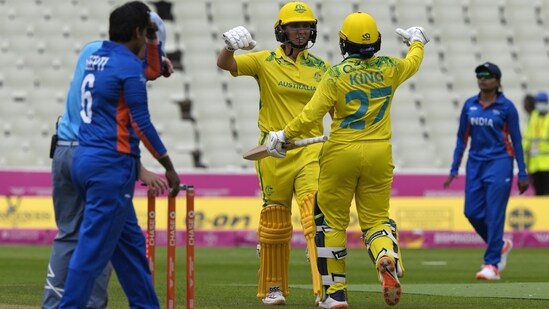Australia find their miracle as India fail to close it out
49 for 5. Alyssa Healy - she who scored 170 off 138 balls in the ODI World Cup final - out for a duck. Beth Mooney - she who scored 78* off 54 balls in the T20 World Cup Final - out, barely into double figures. Meg Lanning - she who has 15 ODI centuries, and a T20I average of 36 - out, not even making it into double figures. And runs on the board. Not just runs, 154 of them, India’s third highest score against Australia.  PREMIUM
PREMIUM
India had Australia exactly where they wanted them. Hell, they had Australia exactly where every team wants to have them, and almost no team ever does. In addition to the big three, India had also dismissed Tahlia McGrath, the player so good she’s kept Ellyse Perry (Yes, the Ellyse Perry) out of this Australian XI.
Scoreboard pressure. Wickets pressure. But the two batters who arrived after this collapse, Grace Harris (37 off 20 balls, SR 185) and Ashleigh Gardener (54* off 35 balls, SR 148.7), just kept hitting, not worrying about the collapse. Despite India doing most things right.
India posted 154 thanks to the brilliance of Harmanpreet Kaur at the death (52 off 34, India scored 47 in the last five overs) and Shafali Verma in the middle (48 off 33, helping India score 57 runs in five overs after the Powerplay). With the ball, Renuka Singh Thakur, a quantity unknown to the Australians, ripped through their top order (4-15) bowling her four overs up front. Sure, India sorely missed the services of Pooja Vastrakar, and had only two seamers on a pitch that had little for the spinners. But largely, India played excellent T20 cricket.
The Australians just played much, much better T20 cricket.
“If you’re going to win games of T20 cricket, it’s not ideal to lose wickets, but out of every T20 match ever played, the average wickets lost in a winning team is 7. Wickets don’t matter so much given you’ve only got 120 balls to face.” This is Harris -she who hit two sixes- speaking after the match. “It’s essentially risk vs reward cricket. It’s about how happy you are with how you get out. If your shot’s a dirty hack across the line, no shape, wrong pitch, wrong line, then you’re probably saying to yourself ‘listen, that’s not the way we want to play’. But if you hole out to deep long on, the ball was there, you keep your shape, you simply didn’t make the best contact, you can live with that.
“We’re encouraged, the Australian cricket team, to take risks. Not unnecessary risks, but take risks, and make them calculated or educated in the scenario that you’re in, the fields that you’ve got, the bowler you’re facing.”
And so, the duo kept taking risks, knowing that they had enough firepower overall to keep taking them. This was a case of one team having more resources than the other, recognising that, and batting in a way that maximises those, without being conservative and underutilising them. “We basically just back our depth in the batting line up,” Harris said.
India don’t have the same depth. It’s hard to imagine the Indian batting line up losing their best three batters, Harmanpreet, Shafali and Smriti Mandhana early, and still being able to pull off a chase like this. In T20I cricket, you need to have at least six match winning batters in your line up. You need six because on any given day, three will fail in the attempt to bat aggressively. That’s just the nature of high-risk cricket. Australia have more than six. Their No. 8, Jess Jonassen, opens the batting in the Big Bash. Harris has been hitting sixes for fun for the Brisbane Heat for years, so it didn’t matter that she last batted in T20I cricket in 2016.
Reward, risk, resources. All terms that cricket fans are used to discussing, but usually in the context of men’s T20 Leagues. It is a testament to the growth of the women’s game that these philosophies are now becoming the norm here as well. Australia are playing a brand of cricket that exploits the resources they’ve invested in. As it happened, they won with an over to spare. Having lost exactly 7 wickets.
Experience unrestricted digital access with HT Premium
Explore amazing offers on HT + Economist Start 14 Days Free Trial Already Subscribed? Sign In
Disclaimer: The copyright of this article belongs to the original author. Reposting this article is solely for the purpose of information dissemination and does not constitute any investment advice. If there is any infringement, please contact us immediately. We will make corrections or deletions as necessary. Thank you.







